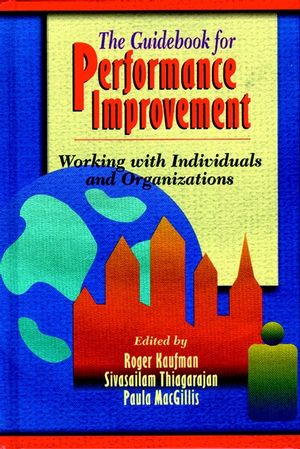The Guidebook for Performance Improvement: Working with Individuals and OrganizationsISBN: 978-0-7879-0353-4
Hardcover
660 pages
December 1996, Pfeiffer
 This is a Print-on-Demand title. It will be printed specifically to fill your order. Please allow an additional 10-15 days delivery time. The book is not returnable.
|
||||||
Introduction: The Changing Realities of Human and OrganizationalPerformance Improvement.
ORIGINS.
The Origins and Critical Attributes of Human PerformanceTechnology.
Research and Development Origins of Performance Systems.
Social Responsibility.
DIRECTION FINDING AND GOAL SETTING.
A Strategic-Planning Framework: Mega Planning.
Preparing Performance Indicators and Objectives.
Needs-Assessment Basics.
A Systems Schema.
ANALYSIS.
Business-Unit Performance Analysis and Development.
Organizational Mapping.
Job-Task Analysis.
DESIGN AND DEVELOPMENT.
The Hierarchy of Interventions.
Applications of Total Quality Concepts to OrganizationalEffectiveness.
Developing Front-line Employees: A New Challenge for AchievingOrganizational Effectiveness.
Job Aids.
Organizational Development for Human PerformanceTechnologists.
IMPLEMENTATION.
Personnel Selection and Assignment.
Recruitment and Turnover.
Accountability for Staff Turnover.
Performance Management.
Program Management: Its Relationship to the Project.
Rewards and Performance Incentives.
Planning Change: Past, Present, Future.
Integrating People, Planning, and Change.
Performance Improvement in Developing Countries.
EVALUATION.
Evaluation: Seven Dimensions, Six Steps, Five Phases, and FourGuidelines.
Performance Is Easy to Monitor and Hard to Measure.
Developing Test and Assessment Items.
Quality Management/Continuous Improvement.
Performance Appraisal.
List of Contributors.
Index.
ORIGINS.
The Origins and Critical Attributes of Human PerformanceTechnology.
Research and Development Origins of Performance Systems.
Social Responsibility.
DIRECTION FINDING AND GOAL SETTING.
A Strategic-Planning Framework: Mega Planning.
Preparing Performance Indicators and Objectives.
Needs-Assessment Basics.
A Systems Schema.
ANALYSIS.
Business-Unit Performance Analysis and Development.
Organizational Mapping.
Job-Task Analysis.
DESIGN AND DEVELOPMENT.
The Hierarchy of Interventions.
Applications of Total Quality Concepts to OrganizationalEffectiveness.
Developing Front-line Employees: A New Challenge for AchievingOrganizational Effectiveness.
Job Aids.
Organizational Development for Human PerformanceTechnologists.
IMPLEMENTATION.
Personnel Selection and Assignment.
Recruitment and Turnover.
Accountability for Staff Turnover.
Performance Management.
Program Management: Its Relationship to the Project.
Rewards and Performance Incentives.
Planning Change: Past, Present, Future.
Integrating People, Planning, and Change.
Performance Improvement in Developing Countries.
EVALUATION.
Evaluation: Seven Dimensions, Six Steps, Five Phases, and FourGuidelines.
Performance Is Easy to Monitor and Hard to Measure.
Developing Test and Assessment Items.
Quality Management/Continuous Improvement.
Performance Appraisal.
List of Contributors.
Index.



